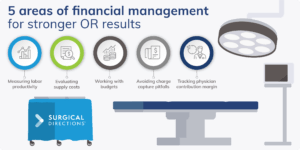Last Updated: October 21, 2024
Most OR leaders are talented nurses who have risen through the ranks. They have strong clinical expertise but usually little background in financial management. And only about a third of OR directors have a business manager on staff.
Recently, senior leaders at Surgical Directions discussed the question, “What financial concepts do OR directors struggle with most?” Surgical Directions is a Chicago-based consulting firm that includes experienced OR clinicians and perioperative business experts. The team identified five areas of financial management where better understanding can lead to stronger OR results.
Measuring labor productivity
A productivity measure needs to be based on a certain stat,” says Alecia Torrance, MBA, BS, RN, CNOR, senior vice president of clinical operations at Surgical Directions. “Some people say our stat is ‘number of cases,’ but that will give you a really inaccurate read on productivity. The problem is that a case can mean anything from cardiovascular surgery to inserting ear tubes.”
Some ORs use complicated productivity formulas based on relative value units. This method accounts for variation in acuity, but it requires a lot of work.
The most effective measure of labor productivity, Torrance says, is worked hours per minute of surgery. For any given time period, obtain worked hours data from human resources and total surgical minutes from the perioperative information system. Worked hours should include both productive and nonproductive time for both direct care and support staff.
“The gold standard for productivity is 0.13 worked hours per surgical minute, which is based on AORN staffing standards,” Torrance says. “Many ORs that we visit are running right around 0.16, but I have seen numbers as high as 0.18.”
OR and finance leaders should review productivity at least monthly, and Torrance recommends checking the metric more often. If your department has poor productivity metrics, examine block time design, preoperative preparation, schedule accuracy, and other factors that contribute to low utilization.
Many OR managers staff to the number of rooms running on a particular day. If 10 rooms are open on Tuesday, management schedules 25 staff members for that day. Instead, you should staff to hour of day running and day of week. The key is to create a more vertical schedule through improved utilization. This will increase productivity significantly as staff levels are trimmed to match the daily draw-down.
Evaluating supply costs
Discussions with hospital executives often focus on hot-button issues like high-cost implants. How do you determine an appropriate level of supply spending, and how do you communicate that to hospital leaders? The most effective spending gauge is supply cost per procedure per surgeon.
Tracking this metric can be a challenge because it is very difficult to calculate costs at the procedure and surgeon level using manual processes. “This really calls for an IT [information technology] solution that enables accurate allocation of supply costs during the case,” Torrance says. “Best practice requires integration between your materials management information system and your electronic medical record.”
Staff should document cases by exception based on accurate preference cards. If charging is set up by exception, the nurse will only be required to amend changes. An alternate methodology for preference card charging is to identify every product opened.
Increasingly, hospitals need to keep total procedure costs below Medicare reimbursement to achieve profitability. Supply costs are often the biggest opportunity to reduce spending, so Medicare payment is a useful yardstick for evaluating supply efficiency.
Working with budgets
In most hospitals, finance staff generate the surgery department budget and send it to OR leadership for approval. This saves work for the OR director, but many directors are not skilled in evaluating budgets critically. “If you cannot read your budget and understand where the numbers are coming from, you really can’t tell whether or not they are reasonable,” Torrance says.
OR directors need to understand what costs or revenue sources are included within each budget line item. For example, disposable supplies often cause confusion. Finance may include some items under “disposables” and others under “contracted services.” Know how they are categorized.
“We always recommend that the OR director sit down with the CFO or controller and clearly define what is included under each budget heading,” Torrance says.
In addition, be ready to provide operational perspective. For example, finance staff must project supply spending by general ledger account and by vendor. But to do this, OR leaders must project supply utilization by specific procedures and items.
Clarifications are important. A monthly budget update may show increases in certain expenses over the same month last year. Finance may conclude that the spend- ing trend is bad. The cause, however, may be that the OR added two surgeons and five new procedures over the last 12 months. Only the OR director or manager can provide this critical piece of information.
Avoiding charge capture pitfalls
When it comes to revenue management, OR directors typically pay most attention to front-end issues such as maximizing utilization and minimizing supply cost variation. Ideally, the director also participates actively in contracting.
But effective OR directors keep a close eye on the entire perioperative revenue cycle, including charge capture.
“It is important to have a process for validating that patients are charged for the appropriate supplies at the appropriate cost,” says Barbara McClenathan, MBA- HCM, BSN, RN, CNOR, senior nurse executive at Surgical Directions. Missed charges are expensive and not as uncommon as they should be, particularly in procedures with multiple hardware components. “Many times a charge will slip through because the nurse missed an item, could not locate an item in the supply dictionary, or simply forgot to enter the charges,” she says.
Accurate charge capture is critical for procedures that do not fall under a global payment. Supplies used during outpatient procedures, for example, are reimbursed individually. “Even for inpatient surgery, certain insurance companies do not pay a blanket price for the entire procedure,” McClenathan says.
“Certain procedures may not be paid if they are coded incorrectly as either inpatient or outpatient,” she adds. “For example, CMS [the Centers for Medicare & Medicaid Services] recently added several laparoscopic colectomy procedures to the ‘inpatient only’ list.”
Tracking physician contribution margin
In general, contribution margin (CM) is net revenue less variable costs. When tracked at the physician level, CM is a powerful tool for managing surgeon-driven spending.
Physician CM equals the total payments for a surgeon’s procedures, minus total variable procedure costs. Tracking physician CM across the entire medical staff will provide insights into how to supplement low-profitability services with higher-margin lines.
This metric can help you evaluate surgeon requests to modify a procedure. For example, if a surgeon wants to perform a certain procedure robotically, good CM data will help you quantify the financial impact of the change.
For inpatient procedures, physician CM can include hospitalization costs. “Some surgeons achieve positive contribution margin in the OR, but not when you look at the entire inpatient stay,” McClenathan says. Tracking this metric allows you to identify surgeons who provide the most cost-effective care.
Efforts to improve physician CM often focus on supply selection and utilization, but adjusting practice patterns can also be helpful. For example, in leading centers many joint replacement patients can be discharged on the first or second day following surgery.
“However, for joint replacements performed on a Friday, it’s almost guaranteed that the patient won’t be discharged until Monday,” says Dhir Desai, senior consult- ing analyst at Surgical Directions. To optimize CM on these procedures, he recommends scheduling most joint replacement patients earlier in the week.
Executive concerns
The most effective OR directors make ongoing financial education a priority, either by seeking a mentor or pursuing formal business education. But the concepts dis- cussed here are a good start to becoming well-versed in OR financial management.
These five concepts represent critical financial management tools that many OR directors and managers have trouble with. They can also help OR leaders stay on top of the performance issues—such as revenue, costs, and productivity—that hospital executives consider most important.
This column is written by the perioperative services experts at Surgical Directions (www.surgicaldirections.com) to offer advice on how to grow revenue, control costs, and increase department profitability.




